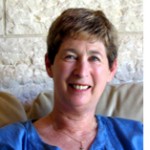By Dorothea Shefer-Vanson

JERUSALEM — It was very gratifying to hear two of our grandsons (aged 22 and 18) express a desire to be taken on a tour of the exhibition entitled ‘By the Rivers of Babylon’ concerning the exile of the Jews of Judea by Nebuchadnezzer II in 586 B.C.E. and currently being held at the Bible Lands Museum, where my husband is a guide.
The tour, in Yigal’s customary thorough fashion, began with a session in front of a large, illuminated wall-map showing the entire Ancient Near East at various stages in its history. Apart from Egypt, the first to establish cities and some form of writing (i.e., ‘civilization’) were the Sumerians (situated in what is now southern Iraq). Their territory was invaded and conquered by the Akkadians from what was known then as Babylon or Akkad, followed by the Assyrians, the Persians, the Greeks, the Romans, the Muslims, the Turks, and finally the British, to name but a few. Finally, following the First World War and the Sykes-Picot Agreement of 1916, the entire area was divvied up among the major European colonial nations, only to disintegrate into mutual enmity, chaos and mayhem in recent years.
The exhibition itself is well done, attempting to arouse interest and provide food for thought for visitors of all ages, with animated films that explain how and why the Babylonian king Nebuchadnezzer II eventually decided he had had enough of the fractious Judeans and their rebellious kings (particularly Joakin, Joachim, and Zedekiah), who rebelled and refused to pay their tribute taxes. After laying siege to and conquering Jerusalem, the troops dealt with the defeated enemy in the manner customary at the time, namely, total destruction of everything in sight, including the (First) Temple, and forced ethnic cleansing by means of mass massacre and exile of the remaining population.
But, as the exhibition shows, the Israelites’ ability to adapt to changing circumstances came to the fore in Babylon. Exhorted by their leaders to display obedience to and cooperation with the authorities, the Jews farmed the land they were granted, established families, adhered to their religion and prospered. When the Persians under Cyrus conquered Babylon in 539 B.C.E. all exiled nations were allowed to return to their lands. but not all the Jews undertook the journey back to Judea. The exhibition displays dozens of clay tablets from the Soffer collection recording transactions undertaken at the time by Jews, primarily in the Jewish settlement of El Yahudo in the region of Babylon.
Those Jews who remained in Babylon flourished for two thousand years, producing inter alia the renowned Babylonian Talmud. Those who returned merged with those who had managed to remain behind in Judea, and eventually built the (Second) Temple, and hung on to it for some five hundred years. Once again, however, internecine conflict and rebelliousness caused the all-powerful Romans to come down upon them with the full force of their might. As everyone knows, this led to the destruction of the Temple in 70 C.E. and the exile that lasted two thousand years and ended only 67 years ago. In a nice touch, the exhibition ends with the reggae song ‘By the Rivers of Babylon,’ recorded by Boney M and popular in the 1970s. The last Iraqi Jews were deprived of their property and expelled from Iraq shortly after the establishment of the State of Israel. Like the many thousands of other Jews who were turned overnight into refugees, they were absorbed into the general population.
No one knows whether the people currently inhabiting the various regions of what was once the Ancient Near East share the same genetic make-up as the original inhabitants of the region. What we do know, however, is that the tendency to engage in mutual warfare involving massacre and enmity on a gigantic scale has endured. Sadly, our newspapers and TV screens are filled on a daily basis with the tragic results of what appears to be a longstanding tradition of mutual intolerance and the desire to dominate others.
Plus ça change…
*
Shefer-Vanson is an author and freelance writer based in the Jerusalem suburb of Mevasseret Zion. She may be contacted via dorothea.shefer@sdjewishworld.com . Comments intended for publication in the space below must be accompanied by the letter writer’s first and last name and by his/ her city and state of residence (city and country if outside the U.S.)